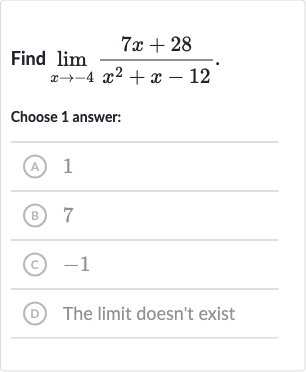Full solution
Q. Find .Choose answer:(A) (B) (C) (D) The limit doesn't exist
- Substitute and Evaluate: First, let's try to directly substitute the value of with into the function to see if it results in an indeterminate form or not.Substitute into .= = = Since we get , which is an indeterminate form, we cannot directly evaluate the limit by substitution.
- Factorize Denominator: Next, we should try to factor the numerator and the denominator to see if there are any common factors that can be canceled out.Factor the quadratic expression in the denominator . can be factored into .Now, let's rewrite the limit expression with the factored form of the denominator.
- Factorize Numerator: Notice that the numerator can also be factored because it is a common factor of .Factor out the common factor of from the numerator. can be factored into .Now, let's rewrite the limit expression with the factored form of the numerator.
- Cancel Common Factor: We can now cancel out the common factor from the numerator and the denominator, as long as is not equal to . Since we are taking the limit as approaches , not at , we can cancel the factors.Cancel the term from the numerator and the denominator.
- Final Substitution: Now that we have a simplified expression, we can substitute into the limit to find the value.Substitute into .= = = The limit exists and is equal to .
More problems from Evaluate exponential functions
QuestionGet tutor help
QuestionGet tutor help
QuestionGet tutor help
QuestionGet tutor help
QuestionGet tutor help
QuestionGet tutor help
QuestionGet tutor help
QuestionGet tutor help
QuestionGet tutor help

